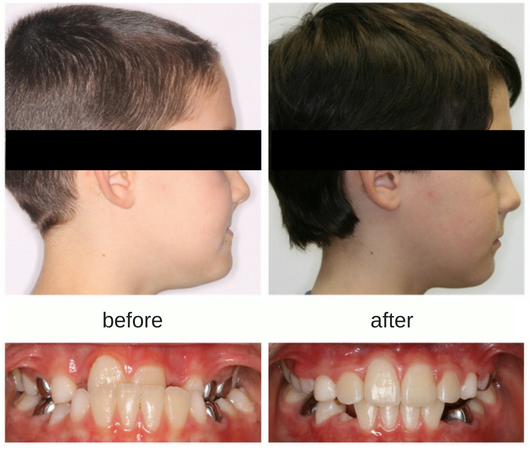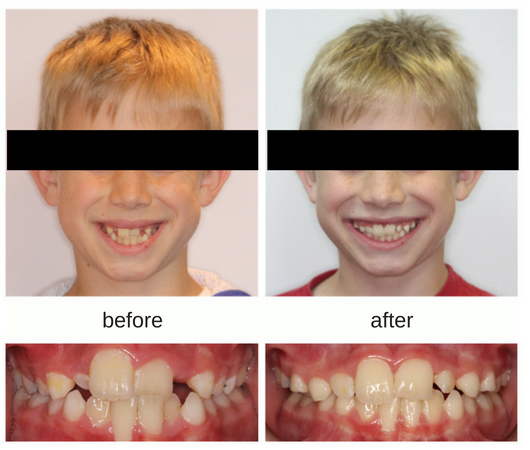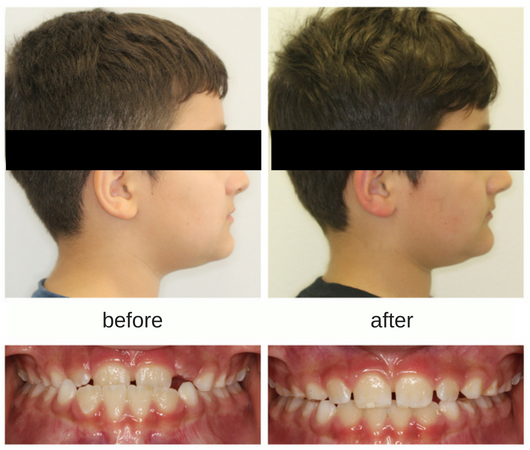Underbites
Maintaining a healthy and comfortable may be difficult when growing up with an orthodontic issue such as an underbite. Recognizing and correcting underbites is one of the reasons that orthodontists like to see patients by 7 years of age. This is the time when children are still growing and their bones are still immature. Early orthodontic treatment in young children can help to correct difficult problems such as underbites and minimize complicated issues in the future.
What is an underbite?
An underbite is a malocclusion or “poor bite” that occurs when the lower teeth and jaw protrude beyond the upper teeth and jaw. Underbites can vary in severity from being mild and barely noticeable to being severe enough that there is a distortion of facial features which may create self-esteem issues in the future.

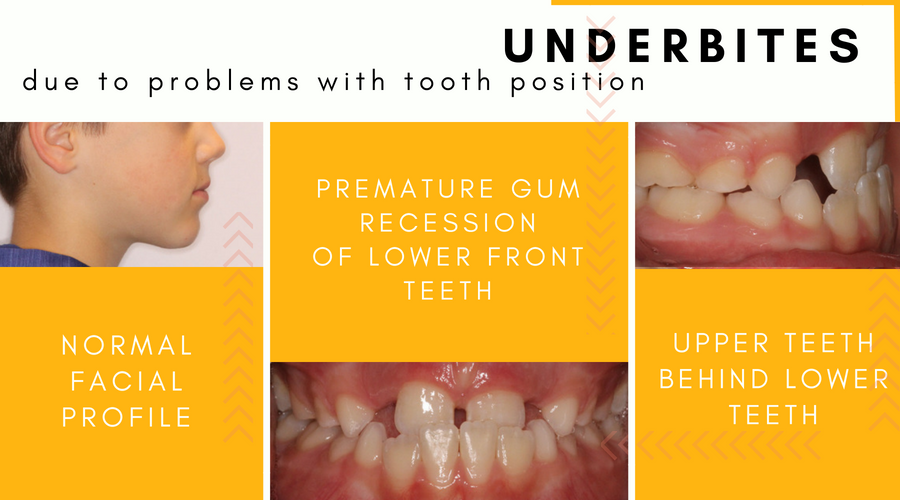
What are the causes of an underbite?
Underbites are typically seen in 5-10% of the general population and usually have a genetic predisposition. If you or someone in your family has an underbite, the likelihood of your child developing an underbite as they grow is high. Some ethnic groups (Asian, First Nations People) are also more likely to develop underbites. Underbites can also occur or worsen due to thumb or digit sucking habits, prolonged pacifier use, a tongue trust, excessive mouth breathing and interferences between upper and lower baby or growing adult teeth.
Complications of underbites in growing children:
- Difficulty speaking, chewing and swallowing
- Poor tooth alignment
- Chronic jaw or joint (TMJ) pain, as well as head- and earaches
- Tooth decay from excessive wear of the tooth enamel
- Chronic mouth breathing, halitosis and bacterial infections
- Sleep apnea, snoring and other nighttime breathing difficulties
- Self esteem issues
How do you correct underbites in children?
Each child is unique and the cause of every child’s underbite is not the same. If steps are taken while the patient is young, the right appliance is often just the thing to resolve the problem. This highlights the importance of early orthodontic screening in children, which should be explored by the age of seven. Whether you come to our Sudbury orthodontics or Mississauga orthodontics office, Dr. Virdee will assess the cause and severity of the underbite, and determine the best course of treatment based on the age of the patient.
If the cause of the underbite is due to a problem with the position of the upper or lower front teeth, this is best corrected with limited braces or a removable retainer. However, if the cause of the underbite is due to excessive growth of the lower jaw, this is best treated with an appliance called protraction facemask in combination with a rapid palatal expander. Because your child is still growing, these appliances take advantage of a child’s natural growth potential to correct the underbite without the need for invasive surgery in the future.
How does an expander and protraction facemask correct an undebite?
A protraction facemask (also known as a reverse pull face mask) is used in combination with an upper jaw expander (rapid palatal expander) to gradually correct the underbite . The expander is inserted first and gently widens the upper jaw (see our treatment of Crossbites to read more about expanders). On the cheek side of the expander, two hooks are used to connect the facemask to the expander with elastics. The facemask rests on the forehead and the chin, which are used as anchors to gently help the upper jaw to grow forward.
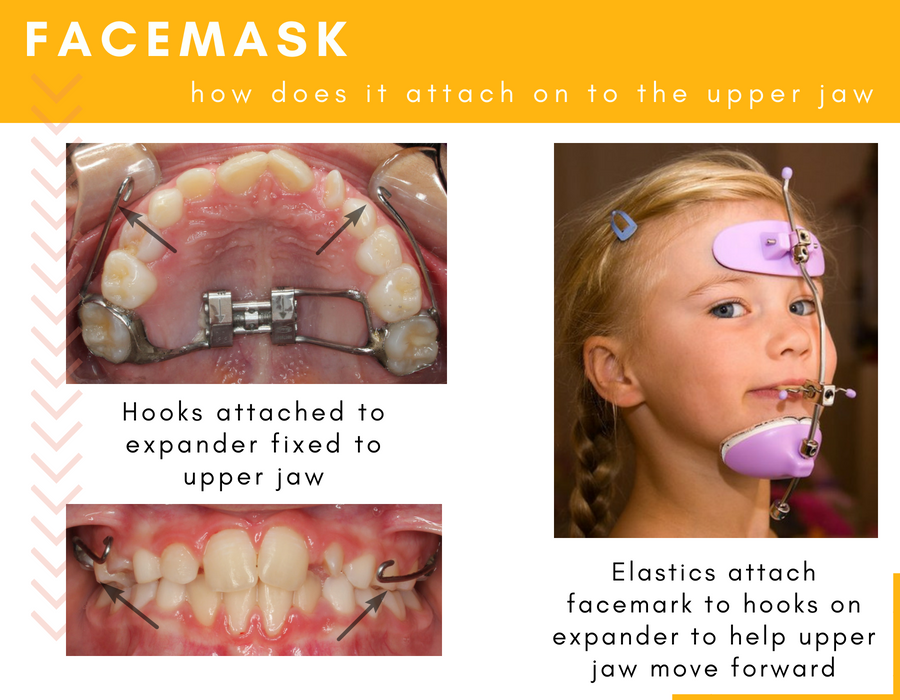
Treatment for underbite correction can range from 6 months to a year depending on your child’s growth potential, the severity of the underbite and compliance with wearing the facemask. Because the bones are less mature in younger patients, the upper jaw is easier to grow. If your child has a severe underbite, it makes sense that it will take longer to correct. The greatest predictor however of treatment success is the patient’s compliance or willingness to wear the appliance at least 12-14h per day.
Does my child wear the facemask to school?
No your child does not have to wear the facemask to school. We ask that you insert the appliance when they get back from school and while they are watching TV and doing homework, or whenever they are at home to maximize the amount of time that they are wearing the appliance. We also ask that the facemask be worn to bed.
How will the appliances used for underbite correction change my child’s day to day life?
Like anything new, your child has to get used to the expander in their mouth. The good news is, because children are more resilient than adults, it’s easier for them to adapt to something new. It usually takes about a week to get used to eating, chewing and speaking with the appliance. When you first start turning the expander, there may be pressure between the two front teeth and a possible gap may develop. We love to see this as orthodontists because this means that the expander is working. Overtime this gap usually closes on its won as the teeth move towards each other. Once facemask therapy is initiated, there may be some pressure on the chin – this is normal and is expected so don’t worry.
Are there other methods of correcting an underbite in young children?
There are other methods of correcting an underbite in young children. These appliances include the Frankle III appliance and the Chin Cup appliance.
The Frankle III appliance:
The Franklle is a removable appliance that patients can insert and remove on their own. There are several claims that this appliance will help to grow the upper jaw, but recent studies have shown that this is not the case. More often than not, the underbite is corrected by moving the teeth (which is a side-effect of this appliance).
But the underbite is corrected! What’s the difference you ask? The difference is that we didn’t take advantage of the child’s natural growth – we didn’t help the upper jaw grow which is the most important treatment modality that we can use. Remember – moving teeth is easy – but growing bone is very difficult. When you have a patient that has an underbite due to a problem with growth of the jaw bones, its important to use appliances that will address the specific problem and not mask the problem, especially when they are growing.
Chin Cup appliance:
The chin cup appliance was used commonly in the 60s and 70s although it is seldom used today. It is a device that wraps around the chin and the top of the head to prevent further growth, movement and protrusion of the lower jaw. Again, based on recent studies, the chin cup has shown to be less effecting at doing what it was intended to do. You cannot stop growth of the lower, but you can help the upper jaw to move or grow to compensate for excessive growth of the lower jaw by using a facemask
What options does my child have if he is no longer at the stage where growth can be used to fix an underbite?
There are many patients and parents that are looking for an orthodontist in Sudbury or an orthodontist in Mississauga that can help them correct underbites. If a patient is close to puberty, treatment with a facemask will likely achieve limited results. In this case we will usually monitor their growth and proceed with treatment options based on growth that is recorded from year to year. If the patient’s underbite is mild and growth is stable where the lower jaw has not grown excessively within the last year of observation, non-surgical treatment using braces, Invisaglin or lingual braces is usually the best option. Moderate to severe underbites with prominent lower jaws often require surgical treatment to achieve desired results. An in depth discussion on surgical orthodontics can be found here.
Please click here to schedule your consultation appointment with Dr. Virdee!
Smile Gallery
-

Jason
-

Remy
-

Gavin
-

Andrew
-

Gavin
Get a Free Consultation
Make an appointment today and start your child’s journey to a healthy and beautiful smile with Hometown Orthodontics.




